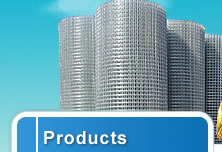317 Stainless Steel Wire Mesh
Type 317 stainless steel wire mesh is the same as Type 316 stainless steel wire mesh except for its slightly higher chromium, nickel, and molybdenum content (18% chromium, 14% nickel, 3% molybdenum) for increased corrosion resistance. Type 317 displays exceptional resistance to pitting in many chemical environments, including sulfurous, acetic, formic, citric, chloride, phosphoric, and tartaric acid solutions and seawater. Some characteristics of 317 stainless steel wire cloth which dictate its use are:
- Austenitic stainless steel.
- Non-magnetic when annealed.
- Slightly magnetic when cold worked.
- Withstands outdoor exposure without rusting.
- Excellent corrosion/pitting resistance in broad range of industrial and chemical settings.
- Better tensile and creep strength vs. T-304 & T-316 at elevated temperatures.
- Resists oxidation at 1700°F temperatures.
- Can be cut, formed, and welded.
Industries & Applications
T-317 stainless steel wire cloth is primarily used in chemical/petrochemical, food processing, and pharmaceutical equipment/medical device industries. Additional industries and applications which commonly use T-317 stainless steel wire cloth include:
- Aerospace
- Automotive
- Liquid Filtration & Particle Separation
- Oil Field & Refinery
- Paper Equipment
- Photographic
- Power Plant
- Textile
Common Aliases
Type 317 stainless steel is also commonly referred to as:
- T-317
- SS317
- UNS S31700
- SUS317 (Japan)
317 Stainless Steel Wire Mesh – Typical Chemistry
| UNS S31700 - 317 Stainless Steel Wire Mesh - Typical Chemistry |
| Alloy |
Standard(s) |
Limits
(%) |
Carbon
(C) |
Manganese
(Mn) |
Phosphorus
(P) |
Sulfur
(S) |
Silicon
(Si) |
Chromium
(Cr) |
Nickel
(Ni) |
Molybdenum
(Mo) |
Nitrogen
(N) |
S31700
317 Stainless Steel |
ASTM A580 |
Min |
0 |
0 |
0 |
0 |
0 |
18 |
11 |
3 |
0 |
| Max |
0.08 |
2 |
0.045 |
0.03 |
1 |
20 |
15 |
4 |
0.1 |
|

